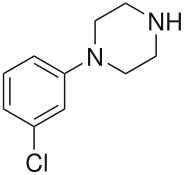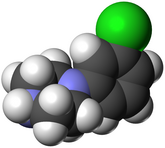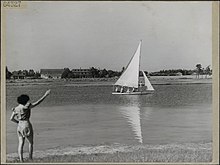메타클로로페닐피페라진
meta-Chlorophenylpiperazine | |
 | |
| 임상 데이터 | |
|---|---|
| 루트 행정부. | 구강, 비강, 직장 |
| ATC 코드 |
|
| 법적 상태 | |
| 법적 상태 |
|
| 약동학 데이터 | |
| 대사 | 간(CYP2D6)[1] |
| 반감기 제거 | 4~14시간[1][2] |
| 배설물 | 소변 |
| 식별자 | |
| |
| CAS 번호 | |
| PubChem CID | |
| IUPHAR/BPS | |
| 켐스파이더 | |
| 유니 | |
| 체비 | |
| 첸블 | |
| CompTox 대시보드 (EPA ) | |
| ECHA 정보 카드 | 100.026.959 |
| 화학 및 물리 데이터 | |
| 공식 | C10H13클론N2 |
| 몰 질량 | 196.68 g/120−1 |
| 3D 모델(JSmol) | |
| |
| |
| | |
메타클로로페닐피페라진(mCPP)은 페닐피페라진 클래스의 정신작용 약물이다.1970년대 후반에 개발되어 2000년대 [3][4]중반 디자이너 의약품으로 판매되기 전까지 과학 연구에 사용되었다.뉴질랜드에서는 불법 자극제에 대한 법적 대안으로 선전되고 있는 알약과 [5][6]유럽과 미국에서는 "불법 자극제"로 판매되고 있는 알약에서 이 알약이 검출되었다.
mCPP는 레크리에이션 물질이라는 광고에도 불구하고, 사실 일반적으로 불쾌한 경험으로 여겨지며 약물 [5]복용자들에게는 바람직하지 않다.강화 효과는 없지만 "심적 자극, 불안 유발, 환각 유발 효과"[7][8][9][10]가 있다.그것은 또한 설치류와 사람에게 [11][12]언어장애, 우울증, 강직성 효과를 발생시키는 것으로 알려져 있으며,[13][14][15][16] 그것에 취약한 개인에게 공황 발작을 일으킬 수 있다.그것은 [17][18][19]또한 장애를 가진 사람들의 강박증상을 악화시킨다.
mCPP는 인간에게 두통을 유발하는 것으로 알려져 있으며 잠재적인 항우울제 [20][21][22]테스트에 사용되어 왔다.그것은 강력한 식욕부진 효과를 가지고 있으며2C 비만 치료를 위한 선택적 5-HT 수용체 작용제의 개발을 장려하고 있다.[23][24][25][26]
약리학
약역학
| 위치 | Ki(nM) | 종. | 참조 |
|---|---|---|---|
| SERT | 202–432 | 인간 | [28] |
| NET | 1,940–4,360 | 인간 | [28] |
| DAT | ND | ND | ND |
| 5-HT1A | 44–400 | 인간 | [27][29] |
| 5-HT1B | 89–501 | 인간 | [27][30] |
| 5-HT1D | 210–1,300 | 인간 | [29][31] |
| 5-HT1E | ND | ND | ND |
| 5-HT1F | ND | ND | ND |
| 5-HT2A | 32–398 | 인간 | [27][10][29][32] |
| 5-HT2B | 3.2–63 | 인간 | [27][33][34] |
| 5-HT2C | 3.4–251 | 인간 | [27][10][32][35] |
| 5-HT3 | 427 | 인간 | [27] |
| 5-HT4 | ND | ND | ND |
| 5-HT5A | 1,354 | 인간 | [27] |
| 5-HT6 | 1,748 | 인간 | [27] |
| 5-HT7 | 163 | 인간 | [27] |
| α1 | 97–2,900 | 인간 | [28][29] |
| α1A | 1,386 | 인간 | [27] |
| α1B | 915 | 인간 | [27] |
| α1D | ND | ND | ND |
| α2 | 112–570 | 인간 | [28][29] |
| α2A | 145 | 인간 | [27] |
| α2B | 106 | 인간 | [27] |
| α2C | 124 | 인간 | [27] |
| β | 2,500 | 인간 | [29] |
| β1 | 2,359 | 인간 | [27] |
| β2 | 3,474 | 인간 | [27] |
| D1. | 7,000 | 인간 | [29] |
| D2. | 10,000 이상 | 인간 | [29] |
| D3. | 10,000 이상 | 쥐. | [27] |
| D4. | ND | ND | ND |
| D5. | 10,000 이상 | 인간 | [27] |
| H1 | 326 | 인간 | [27] |
| mACHRs | 10,000 이상 | 인간 | [29] |
| nAChRs | 10,000 이상 | 인간 | [27] |
| σ1 | ND | ND | ND |
| σ2 | 8,350 | 쥐. | [27] |
| 나1 | 759 | 쥐. | [27] |
| VDCC | 6,043 | 쥐. | [27] |
| 값은 K(nM)입니다i.값이 작을수록 약물이 사이트에 강하게 결합됩니다. | |||
mCPP는 5-HT, 5-HT1A1B, 5-HT1D2A, 5-HT2B, 5-HT2C, 5-HT3, 5-HT7 수용체와 SERT에 [27]유의한 친화력을 가지고 있다.또한 α-아드레날린1 작동성, α-아드레날린2 작동성1, H, I1 및 [27][36]NET에 대한 친화력이 있습니다.대부분의 세로토닌 [37][38]수용체에서 작용제로 작용하며, mCPP는 세로토닌 재흡수 억제제뿐만 아니라 세로토닌 방출제로도 [39]작용하는 것으로 나타났다.
mCPP의 가장 강력한 작용은 5-HT2B 및 5-HT2C 수용체이며, 그 차별적 신호는 주로 [27][40][41]5-HT에2C 의해 매개된다.불안, 두통, 식욕 감퇴와 같은 부정적인 영향은 5-HT2C [12][23][42]수용체에 대한 작용에 의해 매개될 수 있습니다.mCPP의 다른 영향으로는 메스꺼움, 저활동 및 음경 발기가 있으며, 후자는 5-HT2C 활성이 증가한 결과이며, 후자는 5-HT3 [43][44][45]자극을 통해 발생할 수 있다.
비교 연구에서 mCPP는 인간 5-HT2A 및 5-HT2B 수용체에 비해 인간 5-HT2C 수용체에 대한 선택성이 약 10배이다(Ki = 3.4nM 대 32.1 및 28.8nM).[10]인간 5-HT2A 수용체 및2C[46] 5-HT 수용체에서는 부분작용제 역할을 하지만 인간 5-HT2B [47]수용체에서는 길항제 역할을 한다.
약동학
mCPP는 파라히드록시-mCPP(p-OH-mCPP)로 히드록실화에 의해 CYP2D6 이소엔자임으로 대사되며, 이는 그 [1][48][49]대사에 주요한 역할을 한다.mCPP의 제거 반감기는 4~[1]14시간입니다.
mCPP는 트라조돈, 네파조돈, 에토페리돈, 엔피프라졸, 메피프라졸, 클로페리돈, 페르클로폰 및 BRL-15,572를 [49][additional citation(s) needed]포함한 다양한 다른 피페라진 약물의 대사물이다.CYP3A4를 [49]통한 탈알킬화에 의해 형성된다.부프로피온, 플루옥세틴, 파록세틴, 티오리다진과 같은 CYP2D6 억제제를 대사물로 mCPP를 생성하는 약물과 함께 투여할 때 이러한 약물은 모분자(예: 트라조돈)와 MCPP의 [48][1]농도를 증가시키는 것으로 알려져 있으므로 주의해야 한다.
화학
아날로그
mCPP의 유사점은 다음과 같습니다.
- 1-벤질피페라진(BZP)
- 1-메틸-4-벤질피페라진(MBZP)
- 1,4-디벤질피페라진(DBZP)
- 3-트리플루오로메틸페닐피페라진(TFMPP)
- 3,4-메틸렌디옥시-1-벤질피페라진(MDBZP)
- 4-브로모-2, 5-디메톡시-1-벤질피페라진(2C-B-BZP)
- 4-플루오로페닐피페라진(pFP)
- 4-메톡시페닐피페라진(MeOP)
기타 아날로그로는 퀴파진, ORG-12962, 3C-PEP 등이 있습니다.
사회와 문화
법적 상태
벨기에
mCPP는 [50]벨기에에서 불법입니다.
브라질
캐나다
mCPP는 캐나다에서 통제된 약물이 아니다.
중국
2015년 10월 현재 mCPP는 중국에서 [52]통제되는 물질이다.
체코 공화국
mCPP는 체코 [53]공화국에서 합법입니다.
덴마크
mCPP는 [54][unreliable source?]덴마크에서 불법입니다.
핀란드
mCPP는 핀란드에서 불법입니다.
독일.
mCPP는 독일에서 불법입니다.
헝가리
mCPP는 2012년부터 헝가리에서 불법이다.
일본.
mCPP는 2006년부터 일본에서 불법이다.
네덜란드
뉴질랜드
뉴질랜드 정부는 EACD의 권고에 따라 BZP를 다른 피페라진 유도체 TFMPP, mCPP, pFPP, MeOPP 및 MBZP와 함께 1975년 뉴질랜드 약물남용법의 클래스 C에 포함시키는 법안을 통과시켰다.금지는 2007년 12월 18일 뉴질랜드에서 발효될 예정이었지만, 법 개정은 이듬해까지 이루어지지 않았고, 2008년 4월 1일부로 뉴질랜드에서는 BZP 및 기타 나열된 피페라진의 판매가 불법이 되었다.이들 약물의 소지 및 사용에 대한 사면은 2008년 10월까지 계속되었으며, 그 시점에서는 완전히 [56]불법이 되었다.그러나 mCPP는 과학 연구에 합법적으로 사용된다는 점에 유의해야 한다.
노르웨이
mCPP는 노르웨이에서 불법이다.
러시아
mCPP는 러시아에서 불법이다.
스웨덴
mCPP는 스웨덴에서 불법이다.
폴란드
mCPP는 폴란드에서 불법이다.
미국
mCPP는 미국에서 [57]연방 수준에서 예정되어 있지 않지만, BZP의 관리대상 물질 유사체로 간주될 수 있으며, 이 경우 연방 아날로그법에 따라 구매, 판매 또는 소유가 기소될 수 있다.
단, "클로로페닐피페라진"은 플로리다주에서 [58]판매 또는 소유를 불법으로 하는 부칙 I 규제 물질이다.
터키
mCPP는 터키에서 2009년 [59]20월 5일부터 불법입니다.
「 」를 참조해 주세요.
레퍼런스
- ^ a b c d e Rotzinger S, Bourin M, Akimoto Y, Coutts RT, Baker GB (August 1999). "Metabolism of some "second"- and "fourth"-generation antidepressants: iprindole, viloxazine, bupropion, mianserin, maprotiline, trazodone, nefazodone, and venlafaxine". Cell Mol Neurobiol. 19 (4): 427–42. doi:10.1023/a:1006953923305. PMID 10379419. S2CID 19585113.
- ^ Schatzberg AF, Nemeroff CB (2017). The American Psychiatric Association Publishing Textbook of Psychopharmacology, Fifth Edition. American Psychiatric Pub. pp. 460–. ISBN 978-1-58562-523-9.
- ^ Bossong MG, Van Dijk JP, Niesink RJ (December 2005). "Methylone and mCPP, two new drugs of abuse?". Addiction Biology. 10 (4): 321–3. doi:10.1080/13556210500350794. PMID 16318952. S2CID 36169592. Archived from the original on 2013-01-05.
- ^ Lecompte Y, Evrard I, Arditti J (2006). "[Metachlorophenylpiperazine (mCPP): a new designer drug]". Thérapie (in French). 61 (6): 523–30. doi:10.2515/therapie:2006093. PMID 17348609.
- ^ a b Bossong M, Brunt T, Van Dijk J, et al. (March 2009). "mCPP: an undesired addition to the ecstasy market". Journal of Psychopharmacology. 24 (9): 1395–401. doi:10.1177/0269881109102541. PMID 19304863. S2CID 11186375.
- ^ Vogels N, Brunt TM, Rigter S, van Dijk P, Vervaeke H, Niesink RJ (December 2009). "Content of ecstasy in the Netherlands: 1993-2008". Addiction. 104 (12): 2057–66. doi:10.1111/j.1360-0443.2009.02707.x. PMID 19804461.
- ^ World Health Organization. "1-(3-chlorophenyl) piperazine (mCPP) - Expert peer review on pre-review report" (PDF). Retrieved 2021-01-12.
{{cite web}}: CS1 maint :url-status (링크) - ^ Tancer, M. E.; Johanson, C. E. (2001-12-01). "The subjective effects of MDMA and mCPP in moderate MDMA users". Drug and Alcohol Dependence. 65 (1): 97–101. doi:10.1016/s0376-8716(01)00146-6. ISSN 0376-8716. PMID 11714594.
- ^ Tancer M, Johanson CE (October 2003). "Reinforcing, subjective, and physiological effects of MDMA in humans: a comparison with d-amphetamine and mCPP". Drug and Alcohol Dependence. 72 (1): 33–44. doi:10.1016/S0376-8716(03)00172-8. PMID 14563541.
- ^ a b c d Nelson DL, Lucaites VL, Wainscott DB, Glennon RA (1999). "Comparisons of hallucinogenic phenylisopropylamine binding affinities at cloned human 5-HT2A, -HT(2B) and 5-HT2C receptors". Naunyn Schmiedebergs Arch. Pharmacol. 359 (1): 1–6. doi:10.1007/pl00005315. PMID 9933142. S2CID 20150858.
- ^ Rajkumar R, Pandey DK, Mahesh R, Radha R (April 2009). "1-(m-Chlorophenyl)piperazine induces depressogenic-like behaviour in rodents by stimulating the neuronal 5-HT(2A) receptors: proposal of a modified rodent antidepressant assay". European Journal of Pharmacology. 608 (1–3): 32–41. doi:10.1016/j.ejphar.2009.02.041. PMID 19269287.
- ^ a b Kennett GA, Whitton P, Shah K, Curzon G (May 1989). "Anxiogenic-like effects of mCPP and TFMPP in animal models are opposed by 5-HT1C receptor antagonists". European Journal of Pharmacology. 164 (3): 445–54. doi:10.1016/0014-2999(89)90252-5. PMID 2767117.
- ^ Klein E, Zohar J, Geraci MF, Murphy DL, Uhde TW (November 1991). "Anxiogenic effects of m-CPP in patients with panic disorder: comparison to caffeine's anxiogenic effects". Biological Psychiatry. 30 (10): 973–84. doi:10.1016/0006-3223(91)90119-7. PMID 1756202. S2CID 43010184.
- ^ Charney DS, Woods SW, Goodman WK, Heninger GR (1987). "Serotonin function in anxiety. II. Effects of the serotonin agonist MCPP in panic disorder patients and healthy subjects". Psychopharmacology. 92 (1): 14–24. doi:10.1007/bf00215473. PMID 3110824. S2CID 43079787.
- ^ Van Veen JF, Van der Wee NJ, Fiselier J, Van Vliet IM, Westenberg HG (October 2007). "Behavioural effects of rapid intravenous administration of meta-chlorophenylpiperazine (m-CPP) in patients with generalized social anxiety disorder, panic disorder and healthy controls". European Neuropsychopharmacology. 17 (10): 637–42. doi:10.1016/j.euroneuro.2007.03.005. PMID 17481859. S2CID 41601926.
- ^ van der Wee NJ, Fiselier J, van Megen HJ, Westenberg HG (October 2004). "Behavioural effects of rapid intravenous administration of meta-chlorophenylpiperazine in patients with panic disorder and controls". European Neuropsychopharmacology. 14 (5): 413–7. doi:10.1016/j.euroneuro.2004.01.001. PMID 15336303. S2CID 28987431.
- ^ Hollander E, DeCaria CM, Nitescu A, et al. (January 1992). "Serotonergic function in obsessive-compulsive disorder. Behavioral and neuroendocrine responses to oral m-chlorophenylpiperazine and fenfluramine in patients and healthy volunteers". Archives of General Psychiatry. 49 (1): 21–8. doi:10.1001/archpsyc.1992.01820010021003. PMID 1728249.
- ^ Broocks A, Pigott TA, Hill JL, et al. (June 1998). "Acute intravenous administration of ondansetron and m-CPP, alone and in combination, in patients with obsessive-compulsive disorder (OCD): behavioral and biological results". Psychiatry Research. 79 (1): 11–20. doi:10.1016/S0165-1781(98)00029-8. PMID 9676822. S2CID 30339598.
- ^ Pigott TA, Zohar J, Hill JL, et al. (March 1991). "Metergoline blocks the behavioral and neuroendocrine effects of orally administered m-chlorophenylpiperazine in patients with obsessive-compulsive disorder". Biological Psychiatry. 29 (5): 418–26. doi:10.1016/0006-3223(91)90264-M. PMID 2018816. S2CID 37648659.
- ^ Leone, M; A Attanasio; D Croci; G Filippini; D D'Amico; L Grazzi; A Nespolo; G Bussone (July 12, 2000). "The serotonergic agent m-chlorophenylpiperazine induces migraine attacks: A controlled study". Neurology. 55 (1): 136–139. doi:10.1212/wnl.55.1.136. PMID 10891925. S2CID 27617431.
- ^ Martin, Rs; Martin, Gr (2001-02-01). "Investigations into Migraine Pathogenesis: Time Course for Effects of m-CPP, BW723C86 or Glyceryl Trinitrate on Appearance of Fos-Like Immunoreactivity in Rat Trigeminal Nucleus Caudalis (TNC)". Cephalalgia. 21 (1): 46–52. doi:10.1046/j.1468-2982.2001.00157.x. ISSN 0333-1024. PMID 11298663. S2CID 8471836.
- ^ Petkov, V. D.; Belcheva, S.; Konstantinova, E. (1995-12-07). "Anxiolytic effects of dotarizine, a possible antimigraine drug". Methods and Findings in Experimental and Clinical Pharmacology. 17 (10): 659–668. ISSN 0379-0355. PMID 9053586.
- ^ a b Kennett GA, Curzon G (1988). "Evidence that hypophagia induced by mCPP and TFMPP requires 5-HT1C and 5-HT1B receptors; hypophagia induced by RU 24969 only requires 5-HT1B receptors". Psychopharmacology. 96 (1): 93–100. doi:10.1007/BF02431539. PMID 2906446. S2CID 21417374.
- ^ Sargent PA, Sharpley AL, Williams C, Goodall EM, Cowen PJ (October 1997). "5-HT2C receptor activation decreases appetite and body weight in obese subjects". Psychopharmacology. 133 (3): 309–12. doi:10.1007/s002130050407. PMID 9361339. S2CID 7125577. Archived from the original on 2002-01-12.
- ^ Hayashi A, Suzuki M, Sasamata M, Miyata K (March 2005). "Agonist diversity in 5-HT(2C) receptor-mediated weight control in rats". Psychopharmacology. 178 (2–3): 241–9. doi:10.1007/s00213-004-2019-z. PMID 15719229. S2CID 7580231.
- ^ Halford JC, Harrold JA, Boyland EJ, Lawton CL, Blundell JE (2007). "Serotonergic drugs : effects on appetite expression and use for the treatment of obesity". Drugs. 67 (1): 27–55. doi:10.2165/00003495-200767010-00004. PMID 17209663. S2CID 46972692.
- ^ a b c d e f g h i j k l m n o p q r s t u v w x y z aa Roth, BL; Driscol, J. "PDSP Ki Database". Psychoactive Drug Screening Program (PDSP). University of North Carolina at Chapel Hill and the United States National Institute of Mental Health. Retrieved 14 August 2017.
- ^ a b c d Owens MJ, Morgan WN, Plott SJ, Nemeroff CB (1997). "Neurotransmitter receptor and transporter binding profile of antidepressants and their metabolites". J. Pharmacol. Exp. Ther. 283 (3): 1305–22. PMID 9400006.
- ^ a b c d e f g h i Hamik A, Peroutka SJ (1989). "1-(m-chlorophenyl)piperazine (mCPP) interactions with neurotransmitter receptors in the human brain". Biol. Psychiatry. 25 (5): 569–75. doi:10.1016/0006-3223(89)90217-5. PMID 2537663. S2CID 46730665.
- ^ Boess FG, Martin IL (1994). "Molecular biology of 5-HT receptors". Neuropharmacology. 33 (3–4): 275–317. doi:10.1016/0028-3908(94)90059-0. PMID 7984267. S2CID 35553281.
- ^ Hamblin MW, Metcalf MA (1991). "Primary structure and functional characterization of a human 5-HT1D-type serotonin receptor". Mol. Pharmacol. 40 (2): 143–8. PMID 1652050.
- ^ a b Bonhaus DW, Bach C, DeSouza A, Salazar FH, Matsuoka BD, Zuppan P, Chan HW, Eglen RM (1995). "The pharmacology and distribution of human 5-hydroxytryptamine2B (5-HT2B) receptor gene products: comparison with 5-HT2A and 5-HT2C receptors". Br. J. Pharmacol. 115 (4): 622–8. doi:10.1111/j.1476-5381.1995.tb14977.x. PMC 1908489. PMID 7582481.
- ^ Rothman RB, Baumann MH, Savage JE, Rauser L, McBride A, Hufeisen SJ, Roth BL (2000). "Evidence for possible involvement of 5-HT(2B) receptors in the cardiac valvulopathy associated with fenfluramine and other serotonergic medications". Circulation. 102 (23): 2836–41. doi:10.1161/01.cir.102.23.2836. PMID 11104741.
- ^ Porter RH, Benwell KR, Lamb H, Malcolm CS, Allen NH, Revell DF, Adams DR, Sheardown MJ (1999). "Functional characterization of agonists at recombinant human 5-HT2A, 5-HT2B and 5-HT2C receptors in CHO-K1 cells". Br. J. Pharmacol. 128 (1): 13–20. doi:10.1038/sj.bjp.0702751. PMC 1571597. PMID 10498829.
- ^ Bentley JM, Adams DR, Bebbington D, Benwell KR, Bickerdike MJ, Davidson JE, Dawson CE, Dourish CT, Duncton MA, Gaur S, George AR, Giles PR, Hamlyn RJ, Kennett GA, Knight AR, Malcolm CS, Mansell HL, Misra A, Monck NJ, Pratt RM, Quirk K, Roffey JR, Vickers SP, Cliffe IA (2004). "Indoline derivatives as 5-HT(2C) receptor agonists". Bioorg. Med. Chem. Lett. 14 (9): 2367–70. doi:10.1016/j.bmcl.2003.05.001. PMID 15081042.
- ^ Silverstone PH, Rue JE, Franklin M, et al. (September 1994). "The effects of administration of mCPP on psychological, cognitive, cardiovascular, hormonal and MHPG measurements in human volunteers". International Clinical Psychopharmacology. 9 (3): 173–8. doi:10.1097/00004850-199409000-00005. PMID 7814826. S2CID 25464507.
- ^ Samanin R, Mennini T, Ferraris A, Bendotti C, Borsini F, Garattini S (August 1979). "Chlorophenylpiperazine: a central serotonin agonist causing powerful anorexia in rats". Naunyn-Schmiedeberg's Archives of Pharmacology. 308 (2): 159–63. doi:10.1007/BF00499059. PMID 503247. S2CID 19293115.
- ^ Odagaki Y, Toyoshima R, Yamauchi T (May 2005). "Trazodone and its active metabolite m-chlorophenylpiperazine as partial agonists at 5-HT1A receptors assessed by [35S]GTPgammaS binding". Journal of Psychopharmacology. 19 (3): 235–41. doi:10.1177/0269881105051526. PMID 15888508. S2CID 27389008.
- ^ Pettibone DJ, Williams M (May 1984). "Serotonin-releasing effects of substituted piperazines in vitro". Biochemical Pharmacology. 33 (9): 1531–5. doi:10.1016/0006-2952(84)90424-6. PMID 6610423.
- ^ Callahan PM, Cunningham KA (May 1994). "Involvement of 5-HT2C receptors in mediating the discriminative stimulus properties of m-chlorophenylpiperazine (mCPP)". European Journal of Pharmacology. 257 (1–2): 27–38. doi:10.1016/0014-2999(94)90690-4. PMID 8082704.
- ^ Gommans J, Hijzen TH, Maes RA, Olivier B (June 1998). "Discriminative stimulus properties of mCPP: evidence for a 5-HT2C receptor mode of action". Psychopharmacology. 137 (3): 292–302. doi:10.1007/s002130050622. PMID 9683007. S2CID 9265150. Archived from the original on 2002-01-12.
- ^ Kennett GA, Curzon G (May 1988). "Evidence that mCPP may have behavioural effects mediated by central 5-HT1C receptors". British Journal of Pharmacology. 94 (1): 137–47. doi:10.1111/j.1476-5381.1988.tb11508.x. PMC 1853919. PMID 3401632.
- ^ Kłodzińska A, Jaros T, Chojnacka-Wójcik E, Maj J (1989). "Exploratory hypoactivity induced by m-trifluoromethylphenylpiperazine (TFMPP) and m-chlorophenylpiperazine (m-CPP)". Journal of Neural Transmission. Parkinson's Disease and Dementia Section. 1 (3): 207–18. doi:10.1007/BF02248670. PMID 2775468. S2CID 23471213.
- ^ Walsh AE, Smith KA, Oldman AD, Williams C, Goodall EM, Cowen PJ (September 1994). "m-Chlorophenylpiperazine decreases food intake in a test meal". Psychopharmacology. 116 (1): 120–2. doi:10.1007/BF02244883. PMID 7862925. S2CID 40801166.
- ^ Stancampiano R, Melis MR, Argiolas A (August 1994). "Penile erection and yawning induced by 5-HT1C receptor agonists in male rats: relationship with dopaminergic and oxytocinergic transmission". European Journal of Pharmacology. 261 (1–2): 149–55. doi:10.1016/0014-2999(94)90313-1. PMID 8001637.
- ^ Porter, R. H.; Benwell, K. R.; Lamb, H.; Malcolm, C. S.; Allen, N. H.; Revell, D. F.; Adams, D. R.; Sheardown, M. J. (September 1999). "Functional characterization of agonists at recombinant human 5-HT2A, 5-HT2B and 5-HT2C receptors in CHO-K1 cells". British Journal of Pharmacology. 128 (1): 13–20. doi:10.1038/sj.bjp.0702751. ISSN 0007-1188. PMC 1571597. PMID 10498829.
- ^ Thomas DR, Gager TL, Holland V, Brown AM, Wood MD (1996). "m-Chlorophenylpiperazine (mCPP) is an antagonist at the cloned human 5-HT2B receptor". NeuroReport. 7 (9): 1457–60. doi:10.1097/00001756-199606170-00002. PMID 8856697.
- ^ a b Rotzinger S, Fang J, Coutts RT, Baker GB (December 1998). "Human CYP2D6 and metabolism of m-chlorophenylpiperazine". Biological Psychiatry. 44 (11): 1185–91. doi:10.1016/S0006-3223(97)00483-6. PMID 9836023. S2CID 45097940.
- ^ a b c Elliott S (2011). "Current awareness of piperazines: pharmacology and toxicology". Drug Test Anal. 3 (7–8): 430–8. doi:10.1002/dta.307. PMID 21744514.
- ^ "EMCDDA News". www.emcdda.europa.eu.
- ^ "ANVISA resolution - Portaria SVS/MS 344/98".
- ^ "关于印发《非药用类麻醉药品和精神药品列管办法》的通知" (in Chinese). China Food and Drug Administration. 27 September 2015. Retrieved 1 October 2015.
- ^ "Legislativa". www.mzcr.cz.
- ^ "Erowid Psychoactive Vaults : Law : Countries : Denmark (DK) : Denmark bans 2C-T-4, TFMPP, BZP, mCPP, MeOPP". www.erowid.org.
- ^ Koninkrijksrelaties, Ministerie van Binnenlandse Zaken en. "Opiumwet". wetten.overheid.nl.
- ^ "Misuse of Drugs (Classification of BZP) Amendment Bill 2008".
- ^ 21 CFR — 규제물질의 스케줄 §1308.11 부칙 I.
- ^ "Statutes & Constitution :View Statutes : Online Sunshine". leg.state.fl.us.
- ^ "Başbakanlık Mevzuatı Geliştirme ve Yayın Genel Müdürlüğü".
외부 링크
 위키미디어 커먼스의 메타클로로페닐피페라진 관련 매체
위키미디어 커먼스의 메타클로로페닐피페라진 관련 매체




